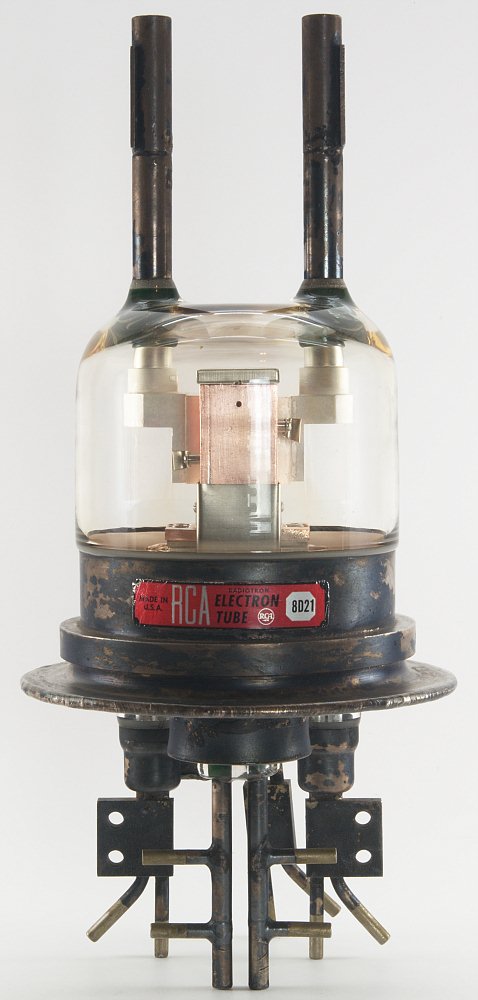Introduction: Forced Air Heater From an Old Transmitting Tube!
---
Hello fellow makers,
A few years back I was lucky enough to come across a box full of old vacuum tubes at a thrift store that I have been using in my projects. In the mix was a few alien tubes that neither I or anyone around me had use for but of course I couldn't simply get rid of them so they became shelf ornaments.
When the Stay Warm contest came along I had an idea to finally make use of one of these tubes, this tube was one of the biggest in my collection and what stood out was its insane filament heater, it is a 5V heater drawing close to 7 amps!

These are high powered transmitting tubes and they require forced air cooling and in some cases even water cooling so you can be assured that they pump out a lot of heat, perfect for a small steampunk desktop heater!
![]()
If you enjoy my Instructables and would like to support my future projects you can Buy Me A Coffee.
Step 1: What You Will Need:
To make your own you'll need:



- A vacuum tube with a large heater
I would suggest looking for a used transmitting tube otherwise the link below is for a rectifier tube that has a 5V 3amp heater.
- A heat reflector
I used an old salvaged headlamp reflector but if you cant find anything similar an enamel bowl will work perfectly well.
Amazon - Enamelware Metal Classic 20oz Bowl
- Access to a 3D printer or an alternative for the base
Amazon - Creality Ender 3 3D Printer
- Brass rod
Amazon - 25 PCS 2 mm Brass Rods
- Brass tubing
Amazon - 9 Pcs 9 Sizes Brass Round Tube Set
- Heat shrink tubing
Amazon - 400 Pcs Heat Shrink Tubing Kit-3:1 Ratio Adhesive Lined
- 5015 Blower fan
Amazon - Cooling Fan 5015 50x50x15mm 5V DC
- Adhesive and fasteners



*As an Amazon Associate I receive a small percentage from sales made through provided links at no cost to you, this helps fund future projects.
Step 2: The Vacuum Tube:
In this project I'm using Valeo "low" power transmitting tube, unlike more common audio tubes that have gone mostly extinct outside of the audiophile circle, vacuum tubes like these are still used in high power RF transmitters, as they can generate more power than modern semiconductor equivalents.
For this reason, you’ll find vacuum tubes in particle accelerators, MRI scanners, and even microwave ovens.

The RCA 8D21 an example of a water cooled transmitting tube
Although I recommend trying to find a discarded old transmitting tube because of their crazy heaters and unique look a more easily accessible option might be to use rectifier tubes.
These tubes are readily found used or even new and although their heaters don't match the craziness of the transmitter tubes they do still draw a fair bit of power and can be used in pairs to up their heat producing power.

A modern 5U4GB rectifier tube that still has a 15W heater
Step 3: The Reflector:
We will be starting with the reflector of the heater.
I picked up this beautiful old tractor headlamp from my local salvage yard a while ago that unfortunately no longer had its lens or glass to transform it into a lamp but it was perfect for this project!
Using some fine steel wool and acetone I scrubbed away to remove years worth of dirt and grime, you don't have to worry about the coating as there are very little chemicals and cleaners that will harm the enamel. Unfortunately there is not much you can do (if you have some tips please let me know!) to get rid of rust stains on the enamel but in this case I didn't mind them as they add to the rustic steampunk look of the heater.

An easier to come by source for a reflector would be some 6 inch enamel mixing bowls.
You will just need to drill your own holes into the side for the fan air outlet, mounting holes and the cable.

Please note that the enamel on the bowl will almost certainly chip off around the holes as you are drilling, this can be fixed with some liquid enamel repair paint or just left as is for a rustic look.
Step 4: The Reflector Stand:
As the tube requires forced air to sink the heat generated by the heaters into the surrounding atmosphere I decided to go with a 3D printed stand for the reflector that will also include a blower (squirrel cage) fan that will supply the tube cool air and in turn give us a toasty breeze.

I hopped onto Fusion 360 to draw the base that was designed around a 5015 blower motor that slots into the bottom and has a large air intake through the back of the base.
The base has a large footprint to keep the heater stable and the design has large voids that can be filled with sand or metal pellets to give it some weight.

The base was printed in ABS as it will be up against the reflector that will get warm, if you are going to be using a low heat resistant filament like PETG or PLA I would suggest adding an insulating washer (like cork) between the reflector and print just as a precaution.
Tube Heater
Attachments
Step 5: The Tube Holders:
We will be making use of the heater pins on the vacuum tube as anchors to hold the tube in place within the reflector.
To make the support posts I will be using 2mm brass rods as they are easy to bend into shape but offer enough strength to hold the tube in place and is also conductive and can be soldered to in order to easily provide power to the tubes heater pins.

We start by bending a loop on one end of the rod, this loop needs to fit around the screw that will hold the reflector onto the base, in my case this was a 3.5mm self tapping screw.
From this loop I bent the rod to follow the curvature of the bowl and made a bend where the second loop will be formed, this length will depend on your bowl/reflector size and tube but you just want it long enough that when it is connected to the heater pins the tube is centred in the reflector.

Next I'll be making some DIY bullet connectors to fit over the heater pins.
As the heater pins for my tube are 5mm I started by taking some 4.5mm inner diameter brass tubing and cut off two 25mm pieces.
Using a diamond cutoff blade in my Dremel I made a 20mm slit down the length of the tube and a cut across the end of the slit to form a "T" as pictured. This will allow the tube to be pushed over the heater pin nice and snug.

We can now bend a loop on the other side of our brass rods that fit snugly around our bullet terminals and then they can be soldered into place. Depending on the wattage of your tubes heater element you might need to use high temperature solder or silver solder to prevent heat creep from melting the solder.

As these mounting rods will power our tube and be fastened against the metal reflector we need to electrically insulate them, you can use some heat shrink (I'd use two layers to be extra careful) but I opted to use some silicone tubing stripped from a piece of wire around the two loops.

Step 6: Assembling:
We can now start assembling our heater!

I started assembly by applying a few small dots of adhesive on the back of the blower fan and sliding it into its slot in the bottom of the base. The wire of the blower fan is fed through the air outlet hole into the reflector.

The reflector can now be screwed onto the printed base using some self tapping screws. Make sure that when you are fastening the back two screws that goes through the support posts that the posts remain completely electrically isolated from the reflector.
The power cable along with the fans wires can now be directly soldered to the support posts, pay attention to your wire colors as the tube does not mind polarity as it is a simple resistive element but the fan does need to be wired in the correct polarity.

Once your wires have been soldered on you can pop the vacuum tube into the bullet connectors and test it out!
Step 7: Powering the Heater:
For lower powered heaters that's under 30 watts you can simply use a USB-C connection but as we go to higher power, larger tubes we will need a beefier power supply.
You can easily get 5V power supplies up to 100W as pictured above and if you need even more power I would suggest putting multiple tubes in series so that you can use more powerful higher voltage power supplies.
Step 8: Enjoy!
I hope you guys find this Instructable useful and if you have any questions please feel free to leave me a message or comment bellow.

Thank you for taking the time to read through my project and as always..
Happy making!
- - -

First Prize in the
Stay Warm Contest














